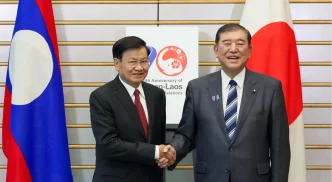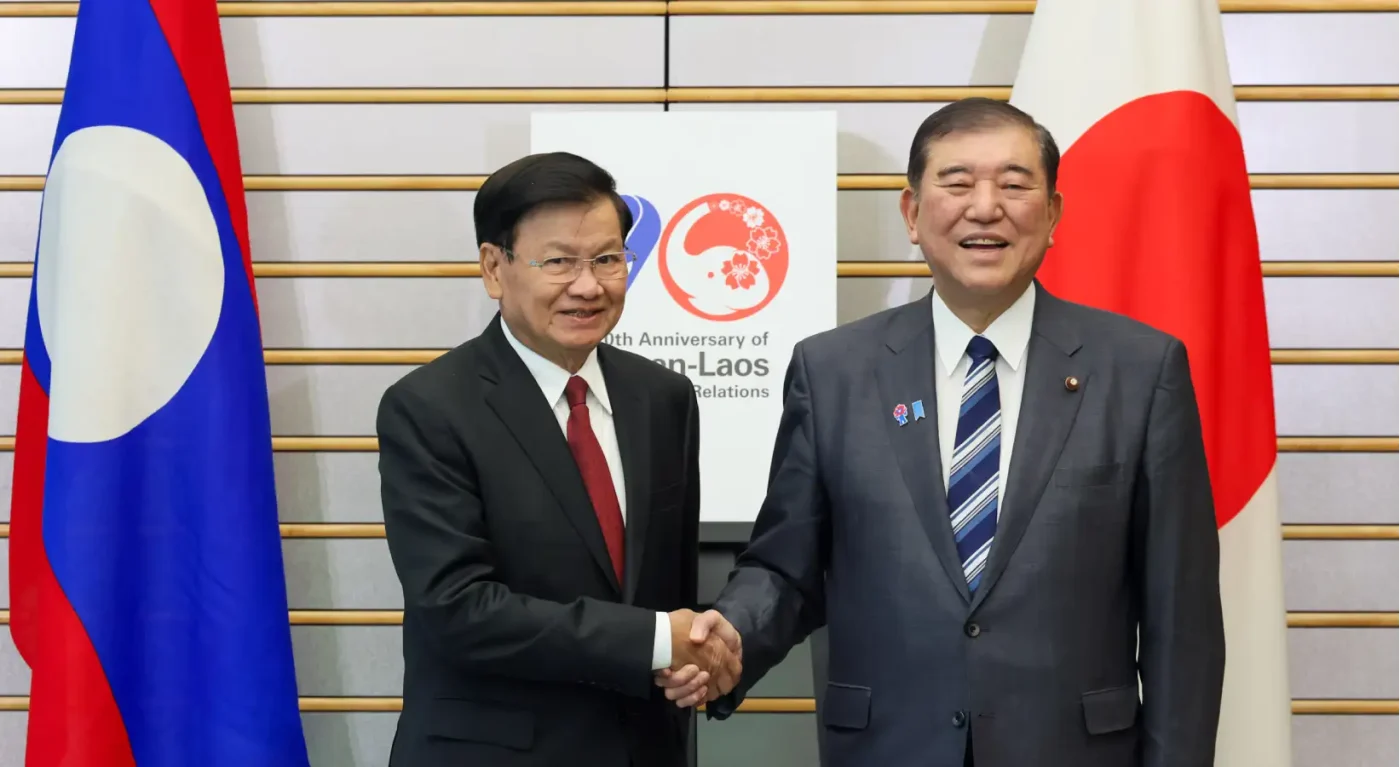In a significant step marking 70 years of diplomatic relations, Lao President Thongloun Sisoulith and Japanese Prime Minister Fumio Kishida have pledged to deepen ties between their nations. The commitment, made during a recent summit in Tokyo, underscores a shared vision for collaboration on economic development, security, and cultural exchange at a time when Laos faces complex domestic and regional challenges.
Seven Decades of Partnership
The relationship between Laos and Japan, which began formally in 1955, has grown into a multifaceted partnership. Japan has long been a key donor and investor in Laos, supporting infrastructure projects, education initiatives, and healthcare programs. During the Tokyo summit, both leaders reaffirmed their dedication to advancing these efforts, with President Sisoulith expressing gratitude for Japan’s contributions to Laos’ socio-economic progress.
“Japan has been a steadfast partner in our nation’s development” said President Sisoulith during a joint press conference. Prime Minister Kishida echoed this sentiment, emphasizing Japan’s commitment to supporting Laos within the framework of a “free and open Indo-Pacific” strategy—a policy aimed at countering China’s growing influence in the region.
The anniversary celebrations included discussions on expanding Japan’s Official Development Assistance (ODA) to Laos, particularly for projects related to renewable energy and rural connectivity. Japan’s investment in Laos has already yielded tangible results, such as the improvement of the National Road 9 corridor, a vital trade link connecting Laos to neighboring Thailand and Vietnam. Analysts suggest that further investments could bolster Laos’ position as a landlocked but strategically located nation in Southeast Asia.
Economic Collaboration and Regional Dynamics
Economically, the strengthened ties come at a critical juncture for Laos, which is grappling with a debt crisis exacerbated by loans from China for ambitious infrastructure projects under the Belt and Road Initiative. Japan’s renewed focus on Laos could provide an alternative source of funding and technical expertise, potentially easing some of the financial pressures. During the summit, both leaders discussed the possibility of trilateral cooperation involving Thailand, a mutual ally, to enhance regional connectivity through the Mekong subregion framework.
Dr. Khamphanh Pheuyavong, a Vientiane-based political analyst, noted that Japan’s engagement with Laos serves a dual purpose. “Beyond economic aid, Japan is keen to reinforce democratic values and governance standards in the region” he said. “This aligns with Tokyo’s broader geopolitical goals, especially as competition with China intensifies.”
Japan’s interest in Laos also extends to security cooperation. The two nations agreed to enhance dialogue on cybersecurity and disaster management, areas where Japan has significant expertise. With Laos facing increasing risks from climate change—such as severe flooding along the Mekong River—Japanese technology and training could prove invaluable. Additionally, both leaders expressed concern over tensions in the South China Sea, though they stopped short of naming any specific actors, reflecting Laos’ cautious approach to regional disputes given its proximity to China.
Domestic Challenges: Illegal Surrogacy Crackdown
While international diplomacy took center stage, domestic issues in Laos also cast a shadow over the summit’s optimism. In a separate development, the Lao government has issued a stern warning against illegal surrogacy, highlighting a growing concern within the country. Under Lao law, engaging in or facilitating commercial surrogacy can result in severe penalties, including imprisonment for up to 19 years. The government’s recent statement, reported by state media, follows a series of cases involving foreign nationals exploiting vulnerable women in Laos for surrogacy purposes.
“The Lao People’s Democratic Republic will not tolerate activities that undermine our laws and exploit our citizens” said a spokesperson for the Ministry of Justice. The statement emphasized the government’s commitment to protecting women and children from trafficking and exploitation, issues that have plagued parts of Southeast Asia for decades.
Illegal surrogacy has emerged as a transnational crime in the region, often involving networks that operate across borders. In Laos, poverty and limited access to education in rural areas make women particularly susceptible to such schemes. The government’s crackdown signals an intent to address these social vulnerabilities, though critics argue that enforcement remains inconsistent due to resource constraints and corruption at local levels.
Japan, for its part, has strict regulations on surrogacy and has faced its own ethical debates on the issue. During the summit, there was no direct mention of collaboration on tackling illegal surrogacy, but sources suggest that Japan could offer technical assistance in areas like border control and anti-trafficking measures as part of broader security cooperation.
Balancing Progress and Challenges
The renewed partnership between Laos and Japan reflects a mutual recognition of shared interests in a rapidly changing geopolitical landscape. For Laos, Japanese support offers a counterbalance to its heavy reliance on Chinese investment, while for Japan, deeper engagement with Laos strengthens its strategic foothold in Southeast Asia. However, the success of this partnership will depend on how both nations navigate regional tensions and domestic priorities.
Laos’ debt burden, estimated at over 100% of its GDP, remains a significant hurdle. While Japanese aid and investment could provide relief, they are unlikely to fully offset the financial obligations tied to Chinese loans. Moreover, Laos must contend with internal governance challenges, including ensuring that foreign assistance translates into tangible benefits for its population rather than being siphoned off by inefficiencies or elite interests.
On the social front, the government’s focus on issues like illegal surrogacy highlights the broader struggle to protect vulnerable communities amid economic disparities. If Japan extends support in areas like education and healthcare—key drivers of social mobility—it could help address some of the root causes of exploitation. Yet, such initiatives require long-term commitment and coordination, areas where past international partnerships in Laos have sometimes faltered.
Looking Ahead
As Laos and Japan embark on the next chapter of their 70-year relationship, the stakes are high for both nations. For Laos, the partnership offers a pathway to sustainable development and greater regional integration, provided it can balance competing influences and prioritize domestic reforms. For Japan, supporting Laos aligns with its vision of a rules-based order in the Indo-Pacific, even as it navigates its own economic and demographic challenges at home.
In Vientiane, reactions to the summit have been cautiously optimistic. Residents and local businesses hope that enhanced ties with Japan will bring job opportunities and infrastructure improvements, while remaining wary of over-reliance on foreign powers. As one street vendor in the capital put it, “We welcome help, but we want to stand on our own feet too.”
With regional dynamics in flux and domestic issues demanding attention, the Lao-Japanese partnership will be tested in the years ahead. Whether it can deliver on its promises remains an open question, one that both leaders—and their publics—will be watching closely.















